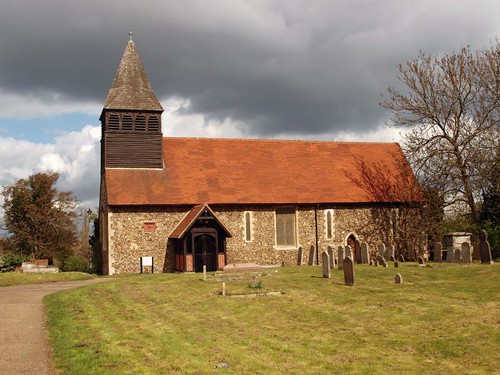ST JOHN THE BAPTIST, 1839-40. Yellow brick, in the lancet style No aisles with W tower and original STAINED GLASS in the E windows.
After a bit of online detective work I found its entry on the British Listed Buildings website:
1839 Church of stock brick in Flemish bond. Tall nave lower chancel and west tower with taller stairs turret at north east,battlemented. Roofs ridged and gabled with eaves clad with grey slate and leaving raised and stone-coped gables. Style severe Early English with lancets. Chancel buttresses angle type, as those of tower, all gabletted with 2 off-sets. Dentil cornice of headers at eaves. Sill band of stone.
St Andrew is another redundant church in what was the village of Netteswell but which is now subsumed by the New Town. Not really my cup of tea but the inside sounds interesting.
ST ANDREW. Nave and chancel in one, C13, and C15 belfry. The belfry has four arched bell-openings in a row on each side and a short broach spire. It stands on two posts and a tie-beam with arched braces. The chancel has lancet windows. Other windows are Perp insertions. It is not possible to decide to what work the brick panel in the S wall near the W end can allude which has the arms of Abbot Rose of Waltham who ruled the Abbey from 1497 to 1500. - PULPIT. Incorporating a frieze with a vine pattern, dated 1618. - BENCHES. Two in the nave with plain poppy-heads. - STAINED GLASS. Two small C15 figures in a N window. - PLATE. Cup and Paten of 1641; Almsdish of 1656. - BRASS. Thomas Laurence d. 1522 with wife and children. - Also a brass of 1607.
NETTESWELL. It was given by our last Saxon king to the abbey of Waltham which he loved so well, and there is on the wall of the 700-year-old church a brickwork panel with the emblems of Abbot Rose of Waltham who died in the last year of the 15th century; it shows a double rose between two long-tailed lions, with a crozier and a hare below. In the church is a pair of medieval lancets facing across the nave, with precious old glass in them. One has the angel, lion, ox, and eagle which were the symbols of the writers of the Gospels; the other has three Marys, two fondling little children, and the third a perfect little study of the Madonna in blue and child. It is a gem of 700 years ago.
There is a figure of another Mary standing by an 18th century monument. She was the wife of William Martin, lord of the manor, a most remarkable lady who sleeps in St Margaret’s Westminster. She saw seven sovereigns on our throne and long before she died (at 97) she set up this monument, by which she stands with remarkable portraits of her brother Robert Crosse and his son Thomas.
There are brass portraits of two families of Tudor and Stuart days, one showing Thomas Laurence and his wife and their five children, the other John Bannister with his wife, three sons, and a baby in swaddling clothes. The font at which these children would be christened is 700 years old and still has the staples by which it was locked against witches. On the wall is a mass dial by which the villagers of those days would tell the time.
The church is almost hidden behind a farm, and in finding it we come upon a 16th century barn and a group of fish-ponds.
There is a figure of another Mary standing by an 18th century monument. She was the wife of William Martin, lord of the manor, a most remarkable lady who sleeps in St Margaret’s Westminster. She saw seven sovereigns on our throne and long before she died (at 97) she set up this monument, by which she stands with remarkable portraits of her brother Robert Crosse and his son Thomas.
There are brass portraits of two families of Tudor and Stuart days, one showing Thomas Laurence and his wife and their five children, the other John Bannister with his wife, three sons, and a baby in swaddling clothes. The font at which these children would be christened is 700 years old and still has the staples by which it was locked against witches. On the wall is a mass dial by which the villagers of those days would tell the time.
The church is almost hidden behind a farm, and in finding it we come upon a 16th century barn and a group of fish-ponds.


No comments:
Post a Comment